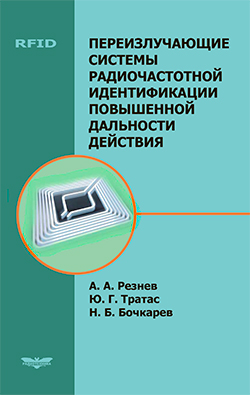Переизлучающие системы радиочастотной идентификации повышенной дальности действия
Рассмотрены особенности распространения радиосигналов в системах на дальних трассах, представлена модель радиоканала, оценена системная помеха, являющаяся основным ограничивающим фактором в части увеличения дальности. С использованием методов статистической теории связи выполнена оптимизация меток, линейных по отношению к считывающему сигналу, с целью увеличения дальности действия системы. Проведен выбор наилучших форм считывающего сигнала и алгоритмов обработки сигналов в приемном устройстве считывателя. Проанализированы варианты систем, осуществляющие обнаружение меток, различение нескольких меток, передачу дискретных сигналов от метки к считывателю, передачу от них аналоговой информации.
Книга может быть полезна специалистам, занимающимся созданием новых систем радиочастотной идентификации, а также студентам и аспирантам, проявляющим интерес к системам RFID.
REEMISSION SYSTEMS
OF RADIO FREQUENCY IDENTIFICATION
WITH INCREASED COVERAGE RANGE
A.A. Reznev, Y.G. Tratas, N.B. Bochkarev
The book is deals with radio frequency identifications (RFID) systems based on reemission sounding signal. The majority of the known publications contains the technological aspects of RFID development, touch upon subjects of technical realization from fabrication of components to offers of the fully turnkey RFID logistic systems.
The Standardization in this area covers the exhaustive nomenclature of possible applications.
At the same time there is a number of radio technical directions for research which are not fully investigated.
One of the important directions of the improvement of the RFID systems is increase in the range of the action, and the improvement of all the main units of the system should be taken into consideration. Regarding the transmitter of the reader it means the optimization of the sounding signal form. Regarding the transponder - the optimization of conversion process to expand capacity to identify and improve noise-immunity in interference conditions. Herewith both external noise and typical for RFID systems interference should be taken into consideration. Regarding the receiver of the reader the improvement means using of the best algorithms of finding and identifications target.
The purpose of the present work is acquaintance of readers with some aspects of the optimization of reemission systems of radio-frequency identifications, which were not widely covered before.
Work consists of seven chapters.
The first chapter is mainly introductory.
The second chapter is dedicated to questions of the evaluation of the range of the action of reemission RFID systems. The known literature describes two situations at calculation of the radio signal fading in systems of radio frequency identification:
1) fading in the near area, when distance is shorter than the wavelength, and
2) spreading of the signal in free space, when distance exceeds the wavelength.
For distant fading at spreading near ground surface is calculated. Besides they offer a model describing total signal at the input receiver of the reader; level and possible ways of compensation of noise modulation of the reading signal coming to the receiver are evaluated. Energy characteristics and action range or RFID systems are identified.
The third chapter concerns the determination of the principles of the building of the optimal systems of radio frequency identification with target, linear to reading signal. Optimization of the features of the linear target for pulsed reading signal is executed in it, optimization of the reading signal form is carried out and optimization of the features of the linear targets for reading signal of the optimum form is realized. One section of the chapter is dedicated to optimization of the procedures of the finding and distinguishing of the targets of the transmission and receiving of discrete and analog information.
Energy features of the targets-transponders are considered in chapter 4. Efficiency of micropower rectifiers is evaluated. Regenerative mode of reflective modulator working is analysed, which allows getting in reemission signal of the information components, the level of capacity exceeding of the reading signal capacity at the target entrance. Transponder analysis based on the parametric generator on varicap with part opening p-n junction is given as example. Last section of the chapters contains the results of the development of the system interference compensator scheme.
Chapter 5 is dedicated to circuit analysis and projecting of he targets with maximum index of reemission reading signal. Schemes of phase modulators are analysed and their optimization is realized. The schemes of the frequency division multiplexing information channels are examined with use of phase modulators to transfer several messages from one target.
Principles of the building of radio frequency identifiers on SAW are described in chapter 6. The main manufacturing technologies of the Transducer for passive radio frequency targets based on SAW are considered. Application of optical photo lithography, nanoimprint and electron-ray lithography for Transducer forming is analysed. Variants of the building of SAW devices are described. The electric features line delays on SAW are optimized.
Chapter 7 is related to nonlinear targets in varicap base. Two variants of such targets are examined, for which are determined energy thresholds of the beginning of corresponding frequency transformation. Ways of solution of such tasks as finding, distinguishing of the targets and transmission of discrete or analog information from them are offered.



